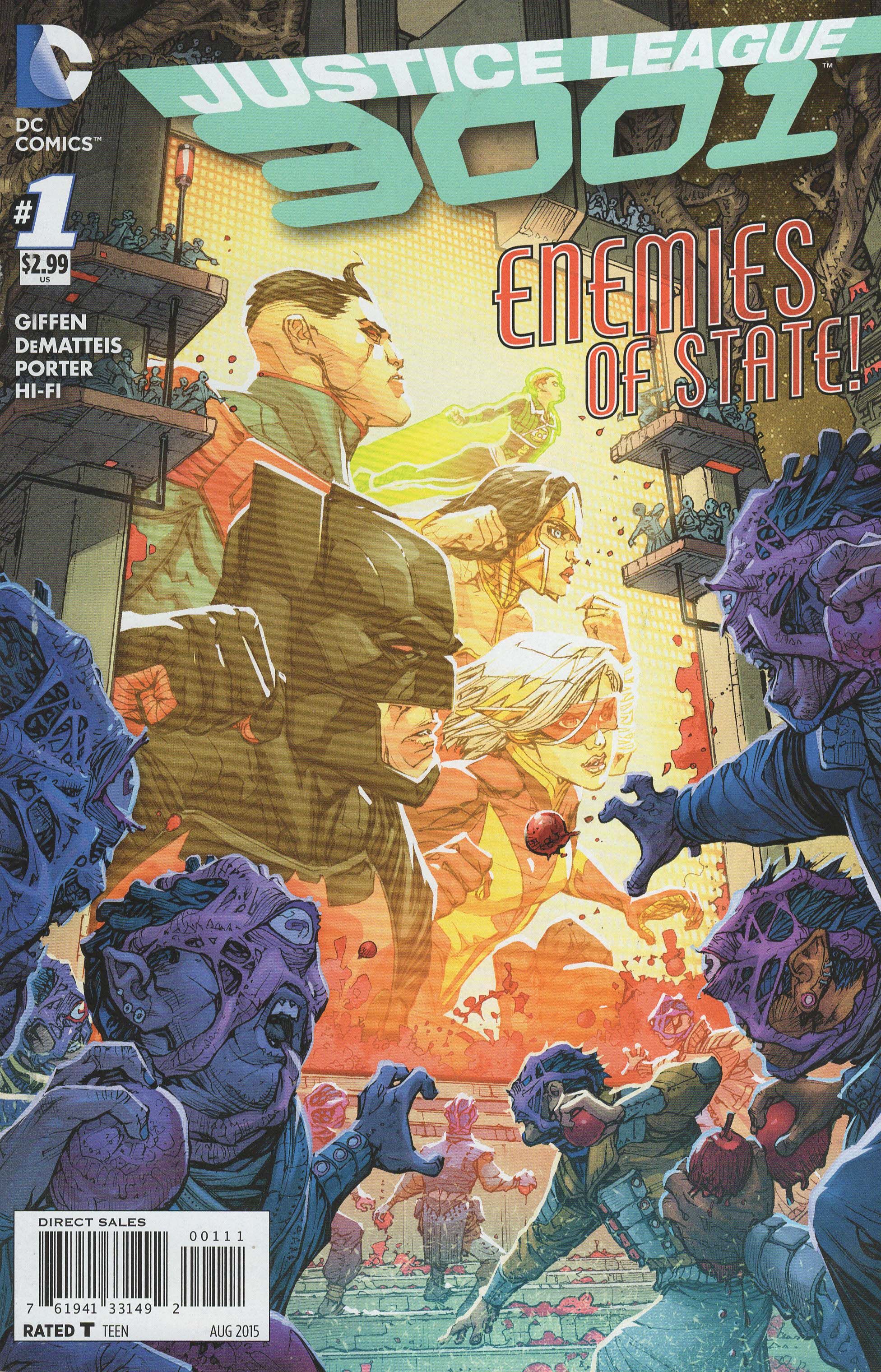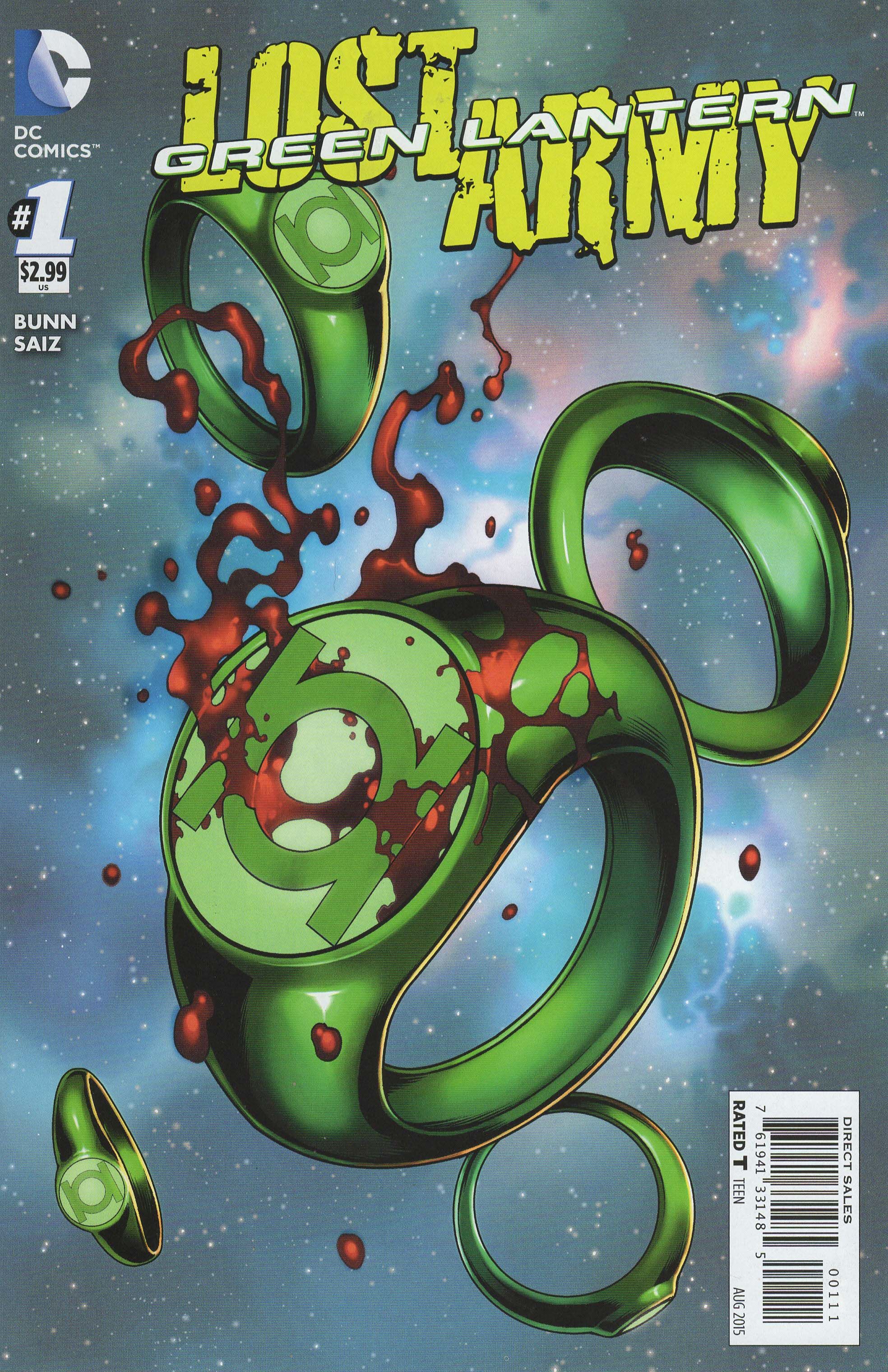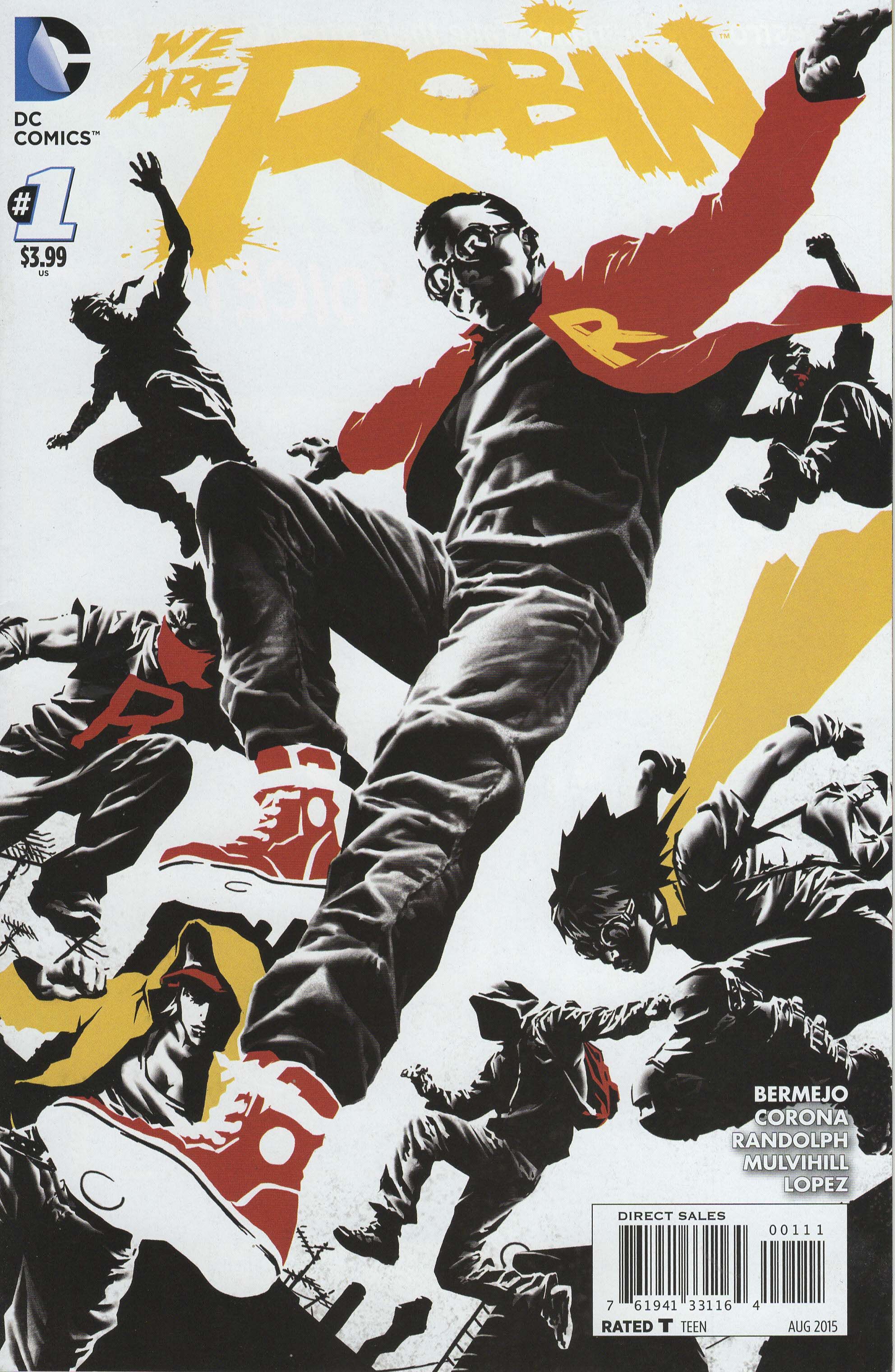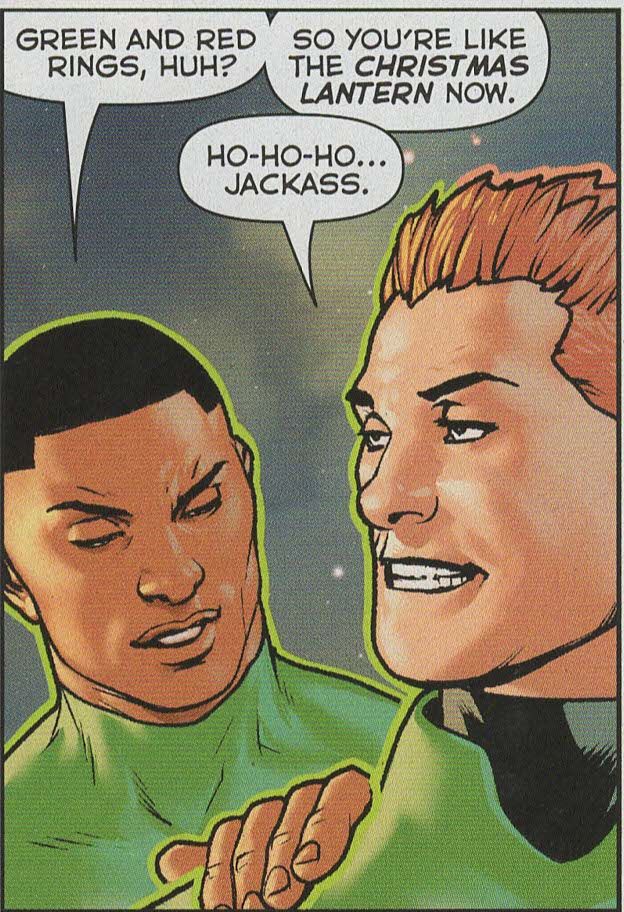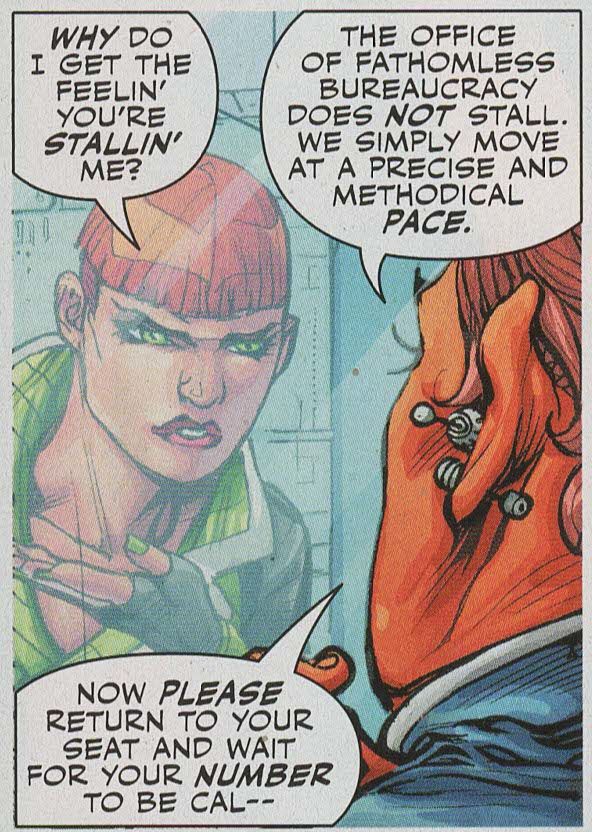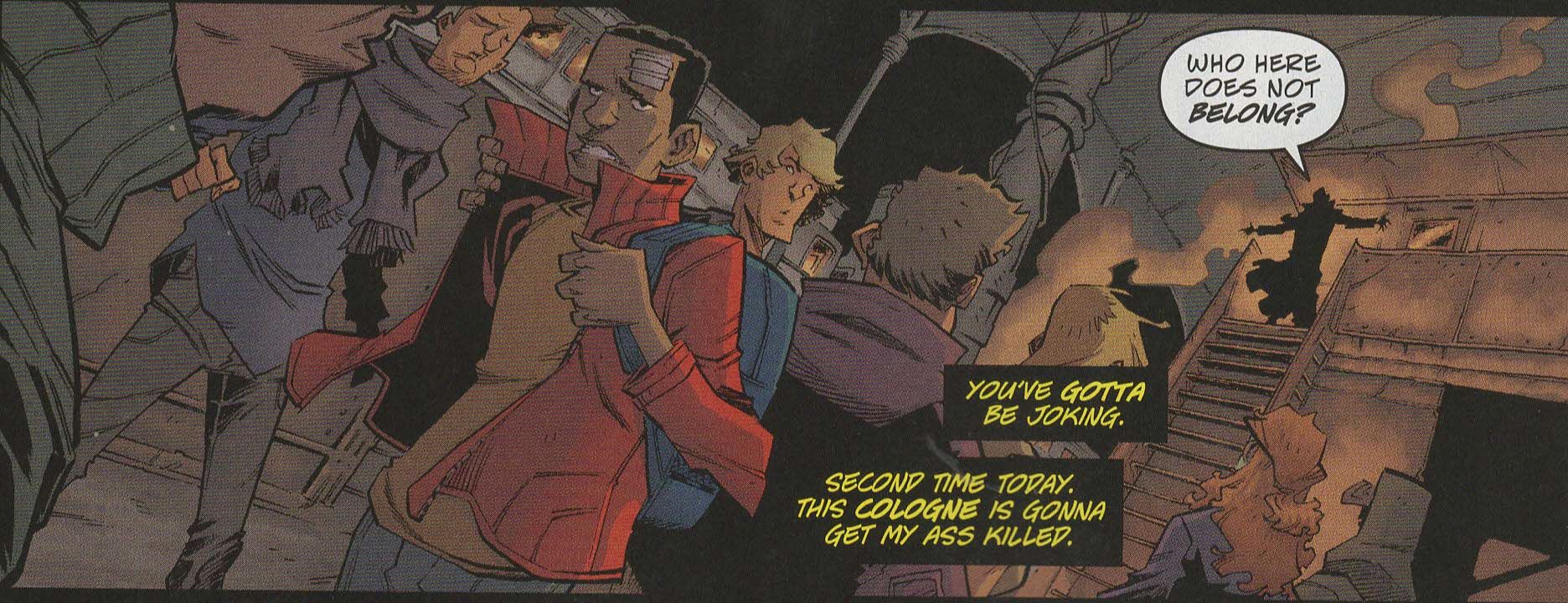After a big week 3, this week DC only released three of the DCYou books. That seems like poor planning. They couldn't have held a few from last week for this week? Oh well - let's check them out!
Green Lantern: Lost Army #1 by Cullen Bunn (writer), Jesus Saiz (artist), Dave Sharpe (letterer), Andrew Marino (assistant editor), and Mike Cotton (editor). $2.99, 20 pgs, FC. John Stewart created by Denny O'Neil and Neal Adams. Arisia Rrab created by Mike W. Barr, Len Wein, and Joe Staton. Kilowog created by Steve Englehart and Joe Staton. Two-Six created by Robert Venditti and Billy Tan. Guy Gardner and Krona created by John Broome and Gil Kane.
I know I'm supposed to read the digital eight-page previews for the DCYou comics, but I really can't be bothered, so I'm just going by what shows up in issue #1, and Bunn begins this in extreme in media res, as John Stewart and some of his Lantern buds are in the middle of empty space, getting menaced by antibodies of the universe that want to eliminate all "foreign matter," which includes sentient beings, I guess. Bunn doesn't explain anything by the end of the issue, either, simply ending on a cliffhanger that has to do with rage. Other than that, there's not a lot of meat on the bone here. Bunn is a good writer, so the dialogue between John Stewart, the other Lanterns, Krona, and Guy Gardner is fine, but a lot of it feels unnecessary. We get a flashback to John's life as a Marine, another flashback explaining why Krona is there and why nobody is punching him, and the discovery of some dead Lanterns that provides a clue to what's going on. It's a strange comic, because there's some fighting, some exposition, but it's seriously decompressed, so while it's done fairly well, it just feels like more of a teaser for the real book, except it's 20 pages long. I don't often rail against the curse of decompression, but I do occasionally, and this is one of those times where "written for the trade" feels more like an insult. If I were a big fan of Green Lantern comics, I'd feel better about this, but I just don't have the level of interest in these characters to overcome the deliberate plotting of this issue. It's too bad, because I do like Bunn and the idea of a lost group of Green Lanterns is a good one (yes, I know this was done with the Legion years ago, but that doesn't mean it's a bad idea!). I assume the trade will be a more interesting read.
Saiz is a good artist, so the book looks nice, although his coloring leaves something to be desired (at least he's coloring the book, so I can't blame a colorist for it). I know that the slick, rendered look is the way to go, but Saiz's rougher art is quite nice, and I can only assume that either he's simply evolving or he's doing something like this because the book is set in the "cleanliness" of deep space. I tend to think it's the former, because the Middle East looks awfully smooth in the flashbacks. Saiz is still a good artist, and he's a good superhero artist, too, so the book looks perfectly fine. He's just lost a little bit of his distinctiveness, which is too bad.
I've been happy with the DCYou books mainly because of their idiosyncrasies, as DC seems willing to let the creators put their individual stamps on the books. Green Lantern: Lost Army is similar to something like Batman Beyond from Week One - a superhero book that functions perfectly well as a superhero book but doesn't really give us anything new. It's fine. Forgettable, but fine. Oh well. I'll be reading Bunn's independent comics if you need me!
Rating: ★ ★ ★ ★ ★ ½ ☆ ☆ ☆ ☆
One totally Airwolf panel:
Justice League 3001 #1 ("Catch a Falling Starro!") by J. M. DeMatteis (scripter), Keith Giffen (plotter), Hi-Fi (colorist), Rob Leigh (letterer), Howard Porter (artist), Harvey Richards (associate editor), and Brian Cunningham (editor). $2.99, 20 pgs, FC. Lois Lane created by Jerry Siegel and Joe Shuster. Fire created by E. Nelson Bridwell and Ramona Fradon. Ice created by Keith Giffen, J. M. DeMatteis, and Kevin Maguire. Starro created by Gardner Fox. Supergirl created by Otto Binder and Al Plastino.
The new #1 for Justice League 3001 is simply the latest issue of Justice League 3000, as it's pretty clear that it's following the plot threads that came up in that series. I thought the first issue of that series was actually not bad, and this is also not bad, although it has the same weakness of that #1 issue - Howard Porter on art. I really like Howard Porter, to be honest, and I think he was a great fit for Morrison's Justice League back in the day and I think the way he's changed his style is quite nice, but he's just not a good fit on a Giffen/DeMatteis "bwah-ha-ha" style comic. Back in the day, when they first started doing this, they had a few artistic missteps along the way, mainly because the artists weren't as good at facial expressions and body language as Kevin Maguire and Adam Hughes were. Porter is a very good superhero artist, and he draws a lot of neat details in this issue that bring the world that Starro has "conquered" (technically, everyone agreed to be Starro-fied, so it's not called a conquest), but the banter between the characters doesn't work as well because Porter just isn't good enough for it. As an avowed advocate for Beatriz da Costa, I should love the scene with Fire and Ice, and while I enjoy reading their dialogue, Porter doesn't give Fire the necessary silliness when she discusses missing Etrigan's huge penis for it to be funny - it just seems weirdly creepy, and yes, that's somewhat due to the dialogue, but Giffen and DeMatteis made some sex jokes in earlier incarnations of their Justice League, and Maguire helped sell it. Porter doesn't. Lois's whining at the beginning about how the Justice League keeps surviving despite her sending them on dangerous missions (in order to get them killed; Lois is the bad guy here) is also less than funny and more pathetic, because Porter can't sell it. Stylistically, I like the way Porter draws. But sometimes, the artist is just mis-matched with the kind of book it is. That's the case here.
Porter isn't the only reason the book doesn't work as well as it could, though. Giffen and DeMatteis have been doing this for almost 30 years (!!!!), and while it's still nice to see, some of the jokes just don't land anymore. Putting Guy's DNA in the body of a woman (however that works in the 31st century) just seems like a way for manly men to feel uncomfortable about staring at her shapely form. It's not that offensive, just a bit tired, especially considering that this is supposed to take place a millennium from now, when presumably sexuality will be even more fluid than it is today. The idea of bureaucracy still stifling everything is not a bad vein to mine, and the writers do a good job with that. The interlude with Fire and Ice is a bit weird, as they are apparently actually from this time period (as opposed to the League, which has characters with superhero DNA injected into them), so they refer to events from the old Justice League series, which seems a bit odd as it doesn't really do anything except remind readers of better comics or confuse readers who've never read them. The idea of Starro colonizing a world and the League not being able to do anything about it because Starro filed the proper paperwork is clever, in a Douglas Adams kind of way, and I guess there's going to be some fisticuffs about it next issue (when Supergirl shows up, too, I suppose). It's a weird comic - somewhat funny on its own, but not as funny as comics it deliberately tries to emulate. I guess that's what happens when you try to Thomas Wolfe something.
This is one of those comics that isn't bad, mainly because at least Giffen and DeMatteis are trying to make it stand out among the vast myriad of superhero books out there. It's not great, but it's not paint-by-numbers, which is nice to see. I just wish Porter could draw a book more suited for him and that Giffen and DeMatteis could find an artist like Maguire or Hughes to sell the humor more. Oh well.
Rating: ★ ★ ★ ★ ★ ★ ☆ ☆ ☆ ☆
One totally Airwolf panel:
We Are Robin #1 by Lee Bermejo (writer), Jorge Corona (artist), Jared K. Fletcher (letterer), Rob Haynes (breakdowner), Emilio Lopez (colorist), Trish Mulvihill (colorist), Khary Randolph (artist), Rebecca Taylor (associate editor), and Mark Doyle (editor). $3.99, 22 pgs, FC. Duke Thomas created by Scott Snyder and Greg Capullo. Leslie Thompkins created by Denny O'Neil and Dick Giordano.
I can't think about this comic without singing "We are Farmers, dum, duhduh-dum, dum-dum-dum" in my head. That's a serious design flaw of the title, I think.
So the premise of this comic is that a bunch of ultra-cool kids want to be Robin, and they recruit Duke Thomas, who I guess showed up in "Zero Year," as their latest one. Meanwhile, someone is observing them, but it's not clear if it's Batman, "Batman," or an official Robin. It's Bat-related, in any case. As this is a first issue, Bermejo can go one of two ways - the "in media res" beginning, like Cullen Bunn does, or the "set-up" beginning, where we're introduced to the protagonist and slowly get involved in the world. Bermejo, probably wisely, chooses the latter route - in the case of GL:LA, Bunn is working with known quantities for the most part, so he can open that way, but Duke is not a known quantity, so we get to know him a little before he gets trapped underground by a Svengali-esque charismatic speaker and almost beaten up before the rest of the Robins, who have been following him, show up. It allows Bermejo to draw us in, making Duke a bit more interesting, before he throws us into what appears to be a fairly standard superhero story. There are some neat things here - Duke's status as an orphan, but poor, makes him an interesting contrast to Bruce Wayne (and Duke's parents, I guess, aren't technically dead, but they're not around because they were infected by - sigh - Joker toxin), and if we recall that in a far different continuity, Leslie Thompkins was a mentor to Bruce as well, her presence in the book is a nice touch (I don't know Thompkins's status in the DCnU, so she might still have mentored Bruce when he was a lad for all I know). Duke is also kind of a dick, which is understandable given his circumstances and adds a bit of spice to the book. The Underground Svengali isn't terribly interesting, but I imagine that Duke will discover he knows something about his parents, which makes him fairly essential to the plot. I'm just waiting for him to tie Batman to a pole and drug him so Monster Truck Batmobile can show up. Bermejo isn't an experienced writer, so I imagine that he wanted to stick to the "set-up issue" playbook as much as possible, and he does so here. I do find the fact that the mysterious narrator at the end says that the future of Gotham is "a place ... of color." S/he means that Robin is more colorful than poopy old Batman, but given DC's recommitment to diversity in their comics (they made one in September 2011, and that didn't work out too well), I wonder if it was meta-commentary as well. I'm not going to break down the diversity of the line again like I did when I reviewed all the New 52 #1s, but this time around, it does seem like there are more minorities headlining books or playing prominent roles. We'll see how it works out for them.
I've never seen Corona's art, but it's quite good. He has an angular style that works nicely in a street-level comic, as no one is terribly smooth about their movements or their fighting. I'm not quite sure what the heck is going on, art-wise - Haynes is credited with breakdowns, which I assume means he laid the pages out, but why did he do that? Is Corona so raw that he's not good at storytelling yet? That's possible. And then Randolph draws the final two pages, and I'm not sure why. I mean, Corona/Haynes can't be behind already, so I assume it's because the mysterious stranger will have a bigger role in upcoming issues, and Randolph will draw those parts to keep the book on track. I don't mind that, but it's a bit odd to see how the division of labor is listed. Meanwhile, Mulvihill is never my favorite colorist - she took the Vertigo "muddy aesthetic" from years ago and really ran with it, and she does so here, as this is a fairly dull comic, color-wise. However, Duke wears a red sweatshirt throughout, and one of the Robins is wearing a yellow coat, so I appreciate the nods toward the costume. But overall, it's a dull comic. That's what you get when you get Mulvihill, unfortunately.
Like some of the other DCYou offerings, this is perfectly fine but completely forgettable. It's not a bad concept, and Bermejo gets us from one point to the other without screwing anything up, but it's just another superhero comic, ultimately. If it lasts for 50 issues or more, I wouldn't be surprised, but if it gets cancelled before the year is out, I wouldn't be surprised either. It's just kind of there, and I imagine it will live or die on the basis of how many Batman fans want to be completists. So there's that.
Rating: ★ ★ ★ ★ ★ ★ ½ ☆ ☆ ☆
One totally Airwolf panel:
So that was a fairly uninspired trio of books this week, but there wasn't anything too terrible, either. It's neat that DC has done this, as it seems like they're recognizing that diversity in their line - I'm not just talking about with the characters, but with the tone of the writing and art - isn't necessarily a bad thing. There were a lot of comics this month that I might not have loved, but I thought was neat that DC was publishing them. Will they continue with their commitment to letting creators do their thing with minimal editorial interference? One can only hope. We'll all be keeping an eye on them!

